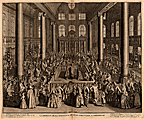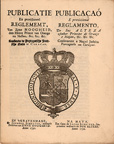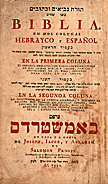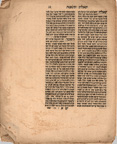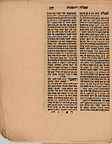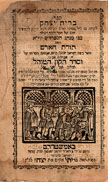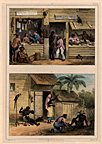|
|
Jews in Curaçao |
|
|
|
51. The religious ceremonies and customs of the several nations of the known world. London: Nicholas Prevost, 1731-1739.
The first volume of this expansive study of the religions and customs of the world is focused on Jews and Roman Catholics. Shown here is the dedication of the Portuguese Synagogue built in Amsterdam between 1665 and 1675. At the time of completion, it was the largest synagogue in the world. The Portuguese Jewish community in the Netherlands was vital to the Jews in the Atlantic colonies, providing them with rabbis, books, and guidance on the application of Jewish law. Numerous copperplate engravings lent great visual appeal to the series written by Jean Frédéric Bernard (d. 1752) and illustrated by Bernard Picart (1673-1733).
|
|
|
|
|
|
| |
|
52. United Provinces of the Netherlands. Publicatie en provisioneel reglement, van Zyne Hoogheid, den Heere Prince van Orange en Nassau ... raakende de Portugeesche Joodsche natie te Curacao = Publicaçao e provizional reglamento de Sua Alteza osenhor Principe de Orange e Nassau ... consernente a Naçao Judaica Portuguesa em Curaçao.The Hague: Jacobus Scheltus, 1750.
Issues of ecclesiastical government, familiar from New England history, gave rise to procedures for establishing new congregations as settlements grew, and to instruments developed to ensure religious orthodoxy, such as the Saybrook Platform. But a world away, among the Jewish population of Curaçao, some of these same issues were in play in the eighteenth century.
The first Curaçao synagogue, Mikve Israel, was established in 1651. Later, travel difficulties caused by an expanding population led to pressure for a new synagogue, and in response to repeated requests, the religious council in Amsterdam permitted the establishment of a second synagogue, Neve Shalom (Dwelling of Peace), under the jurisdiction of Mikveh Israel. The new sanctuary was consecrated in 1746, and a supporting school was founded soon afterward.
In time, the leadership of Neve Shalom began chafing under the rule of the old guard and relations gradually worsened. Dissension grew into strife, even to fistfights. By 1750, the Jewish population was split between the two sides and the conflict began disrupting the economic life of the island. Problems continued until the States General appointed a commission to resolve the matter, and in 1750 an edict was signed enacting nine articles that established peace and congregational autonomy. A solemn Thanksgiving Service was held in Mikve Israel, and both Jewish congregations flourished. This official pamphlet of resolution was printed in Dutch and Portuguese. |
|
| |
|
|
|
| |
|
53. Bible. O.T. Hebrew. 1762. Biblia : en dos colunas hebrayco y español.
Amsterdam: Joseph, Iacob, & Abraham de Salomon Proops, 1762.
Although Hebrew and Yiddish Bibles began to be printed in the mid-sixteenth century and the Bible appeared regularly in Spanish language editions after the publication of the great Ferrara Bible of 1553, this is the first time that Hebrew and Spanish texts of the Bible appear in the same volume. It is also the first Hebrew book whose publication was financed by, and for, American Jews. Motivated by the needs of pupils on Curaçao, who did not have access to enough copies of the Pentateuch in Hebrew and Spanish to go around, Abraham Mendes de Castro sent funds to Amsterdam in 1760 to print a bilingual text. The profits from the sale went to the Jewish communities of Hebron and Jerusalem. The result was judged to be “one of the most beautiful of the Spanish Bibles.”
The gift of Rabbi Eliezer Horowitz. |
|
| |
|
|
|
| |
[Perî 'êz Hayyim]. [Amsterdam, 1691-1807].
This Hebrew periodical, “Fruit of the Tree of Life,” was printed for over a century and was devoted to Halakhic responsa, legal miscellanea, interpretations of the Talmud, and commentaries. Issues appeared weekly or monthly, giving advice and answers with expert scholarly opinions on such matters as inheritance laws, social conflicts, civil claims, the shipping of merchandise, piracy, and topics relating to marriage, as well as some occasional narrative or literary piece. Most opinions were dated and signed by the rabbis who prepared them, but were not considered final religious judgements. These publications allowed Dutch and colonial Jews to live fully within their religious tradition, even though some questioners no longer understood Hebrew. Complete runs of the long series are unknown, due to the small number of copies printed of each issue. The JCB holds three issues, each focused on a problem of colonial life. |
|
| |
|
|
|
| |
|
55. [Perî 'êz Hayyim]. [Amsterdam, May 1763].
Peri Ez Hayyim was issued by the well-known yeshivah Ez Hayyim, founded in 1616. The issue shown here concerns the divorce case of Jacov, an Amsterdam businessman, who intended to travel to Curaçao in the Netherlands Antilles, off the Venezuelan coast. Before he boarded the ship he set up a bill of divorce (get) for his wife, in case he did not return from the perilous journey, because under Jewish law only the husband can institute divorce proceedings. Jacov started his journey, but due to problems with the ship, had to return to Amsterdam and continued to live with his wife for another six months before he traveled again to Curaçao. Unfortunately, this time he never came back. The question was now whether his wife was entitled to receive the divorce paper. Rabbi Moses Rodriguez Lopez advised against the get due to chronological considerations. |
|
| |
|
|
|
| |
|
56. [Perî 'êz Hayyim]. [Amsterdam, May 1764].
This issue from 1764 concerns an inheritance case involving a Jewish woman who lived in Amsterdam, and her son who lived in Curaçao in the Netherlands Antilles. A Dutch couple had a daughter; the wife died, and the husband remarried. Since his business did not go well, he traveled overseas and never returned. As the man’s second wife was about to die she stipulated that her inheritance should go to a son from a previous marriage. The son lived in Curaçao and was expected to return in the near future. The woman’s step-daughter asked for legal advice since (1) it was not certain that her father was actually dead and (2) why should a distant son of her stepmother inherit what her father had earned? Rabbi Moses Rodriguez Lopez decided in favor of the daughter, agreeing that she, not her step-mother, would be entitled to her father’s inheritance. However, the daughter still needed to get the permission of the Chief Rabbi of Amsterdam. |
|
| |
|
|
|
| |
|
57. [Perî 'êz Hayyim]. [Amsterdam, 1767].
An island resident named Reuben bought a young female slave. When he needed to travel to Amsterdam on business, friends advised him not to take her with him due to their understanding that Amsterdam’s laws were in conflict with slavery. Reuben’s friend Simeon offered to be the girl’s guardian during the business trip, and agreed to provide her food in exchange for work. After two years Reuben returned and learned that the slave had borne a son. His friend Simeon indicated that he would return the girl, but planned to retain the child as his property, since its father was his own slave. Reuben, on the other hand, regarded the child as an extension of the girl, and therefore his property. He asked the Rabbi in Amsterdam for a judgment. The ruling referred to precedents in the Talmud and the writings of Moses Maimonides, specifically based on marriage law and tradition governing slaves. The judgment favored the child’s retention by the mother. The Rabbi offered that his opinion was in compliance with the laws of the islands, where the entire trade is of slaves and their labor. Signed by David Meldola, son of Raphael Ledolah, Amsterdam, 5517 [i.e., 1767]. |
|
| |
|
|
|
| |
|
58. [Sefer Berit Yitshak]. Amsterdam : [Gerard Johan Jansen in the shop of Israel Mondove], 5528 [i.e., 1767 or 1768].
Originally published in Amsterdam in 1729, this colonial artifact testifies to the continuance of Jewish ritual observance in the Caribbean region. The translated title reads: “The Book of Isaac’s Circumcision. To be read the Evening previous to the circumcision.” The text includes “Seder milat avadim” (order of circumcision of slaves), intended for use by Jews in the Caribbean islands, and a list of mohalim (who conduct the circumcision) in Portuguese at the end of the book, including those resident in Curaçao and Suriname.
Purchased with the assistance of the JCB Associates. |
|
| |
|
|
|
| |
|
Jews in Surinam |
|
| |
|
|
|
| |
|
59. Essai historique sur la colonie de Surinam. Paramaribo, 1788.
David Nassy is thought to be a principal author of this essential historical essay on the colony of Suriname, its foundation and development, which includes the history of the Sephardic and Ashkenaz nation established there. The dedicatory epistle is signed: Mos. Pa. de Leon., Saml. Heo. de la Parra., Ishak de la Parra., David de Is. C. Nassy., and Samuel Whel. Brandon.
|
|
| |
|
|
|
| |
|
60. John Gabriel Stedman. Narrative, of a five years' expedition, against the revolted Negroes of Surinam, in Guiana, on the wild coast of South America, from the year 1772, to 1777. London : J. Johnson, 1796.
Stedman provided an important account and some drawings of the Jewish Savannah (Joden Savane), a settlement in the interior of Suriname. “Here Jews have a beautiful synagogue, keep their solemn fasts and festivals; here they also have their capital schools and seminaries ... These people possess particular rights and privileges in this colony with which they were endowed by King Charles the Second; when the settlement of Surinam was English; and such are these privileges I never knew Jews to possess in any other part of the world whatever.” Many of the plates prepared from Stedman’s original drawings were engraved by the young William Blake, others by Bartolozzi, Thomas Conder, Thomas Holloway, Inigo Barlow, Perry, Benedetti, and A. Smith. |
|
| |
|
|
|
| |
 |
61. John Gabriel Stedman. I. G. Stedmann's Reisen in Surinam. Berlin : In der Schüppelschen Buchhandlung, [1799].
The location of the Jewish Savannah (Joden Savane) in the interior of Surinam, on the Surinam River appears on this map from the German translation of excerpts from Stedman’s Narrative. Also shown on the map are various indigenous villages and communities of self-emancipated slaves. |
|
| |
|
|
|
| |
|
62. Pierre Jacques Benoit. Voyage à Surinam. Brussels: Société des beaux-arts, 1839.
The illustrations for this series, prepared by Paul Lauters (1806-1875) and Jean-Baptiste Madou (1796-1877), provide unique portraits of Jewish and African daily life in Suriname in the early nineteenth century. Here an African tailor’s shop stands next door to a Jewish chandlery. The shopkeeper offered Dutch gin, trinkets, toys, and decorative articles, in addition to staples. |
|
| |
|
|
|
Exhibition prepared by Dennis Landis , Curator of European Books.



